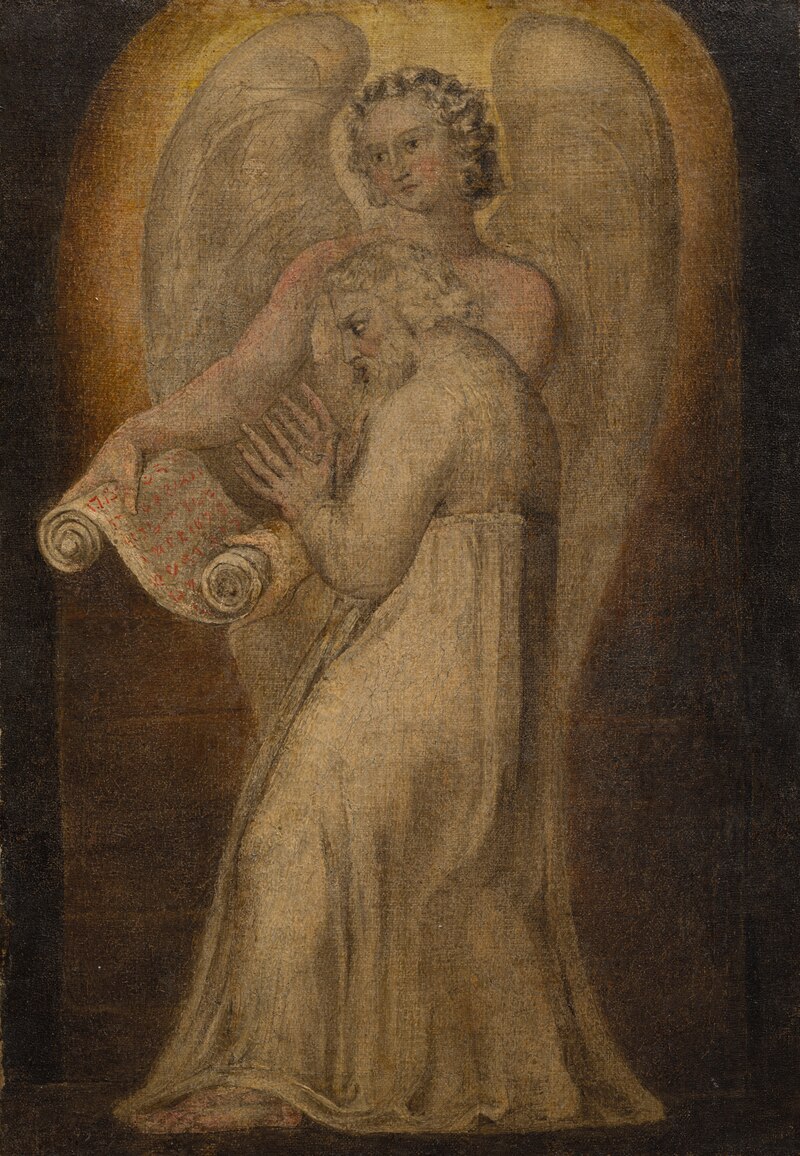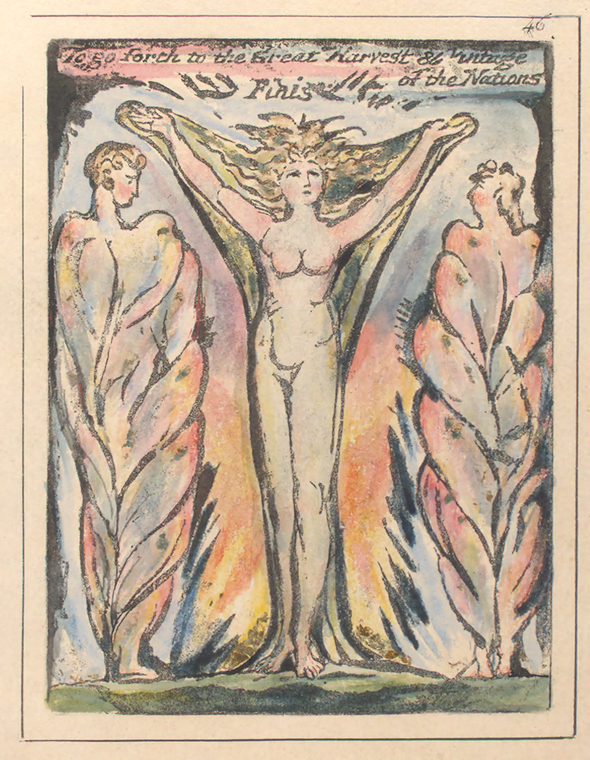 |
Yale Center for British Art
Tempera with pen and black ink on a copper engraving plate
The Horse |
Blake had a long history of being disappointed in dealings with commercial printing projects. Another occurred when Hayley originated an enterprise in which Blake was to illustrate some ballads for children which Haley would provide. The local printer Seagrave would do the letterpress printing while Blake would supply four engravings for each poem. The expenses and the profits would both accrue to Blake. Hayley was trying to teach Blake to accumulate wealth but it didn't work out that way. Hayley and his affluent friends did not purchase enough copies to cover Blake's monetary expense, much less the labor that he and Catherine spent on engraving, printing, collating and distributing.
Four of the projected sixteen ballads with their illustrations were released as broadsides about 1802. Later Blake engraved additional plates allowing for the publication of a book in 1805.
Blake wrote to Hayley of his extreme disappointed that his engraving of The Horse was to be eliminated from the published book. The engraving work had already been done but he would not be paid if the ballad was not included. The Yale Center of British Art owns the painting which Blake made of his engraving of The Horse and considers it "the gem of the painting collection." A reproduction of the engraving, colored by Blake, is included in G.E. Bentley's Biography of William Blake (Pt 97.) It is a tiny image, 4 3/16 x 2 1/2 inches, done with meticulous care, richly colored and showing dimension and tension.
I think that Blake's fondness for this image may have rested on more than the quality of his workmanship. I see in the woman the face and composure of Blake's Catherine. Her defense of the child from harm, is the protection which she gave to the work through which she and her husband made imagination manifest. The energy of the horse which dominates the picture is not suppressed but contained. Notice that the drama takes place below the surface of the ground and above the surface of the water. Perhaps Blake represented three kinds of strength in his image. The horse has the ferocity of creative energy seeking expression, the woman has the serenity of spirit whose power would not be overcome, the child received not only protection but release to carry her independent identity where it led her.
Letters, (E 762)
[To William Hayley]
[22 January 1805]
"I must now express
my thanks for your generous manner of
proposing the Ballads to him on my account, and inform
you of his advice concerning them; and he thinks that they should
be published all together in a volume the size of the
small edition of the Triumphs of Temper, with six or
seven plates. That one thousand copies should be the first
edition, and, if we choose, we might add to the number of plates
in a second edition. And he will go equal shares with me in the
expense and the profits, and that Seagrave is to be the printer.
That we must consider all that has been printed as lost, and
begin anew, unless we can apply some of the plates to the new
edition. I consider myself as only put in trust with this work,
and that the copyright is for ever yours. I therefore beg that
you will not suffer it to be injured by my ignorance, or that it
should in any way be separated from the grand bulk of your
literary property. Truly proud I am to be in possession of this
beautiful little estate; for that it will be highly productive I
have no doubt, in the way now proposed; and I shall consider
myself a robber to retain more than you at any time please to
grant. In short, I am tenant at will, and may write over my
door, as the poor barber did, "Money for live here."
I entreat your immediate advice what I am to do, for I would
not for the world injure this beautiful work, and cannot answer
P[hillip]'s proposal till I have your directions and commands concerning
it; for he wishes to set about it immediately, and has desired
that I will give him my proposal concerning it in writing.
I remain, dear Sir,
Your obliged and affectionate
WILL BLAKE"
[From the Gilchrist Life]
Letters, (E 763)
To William Hayley Esqre Felpham
near Chichester, Sussex
Friday [22 March 1805; Postmark: 25 March]
Dear Sir
This Morning I have been with Mr Phillips & have intirely
settled with him the plan of Engraving for the new Edition of the
Ballads--The Prints 5 in Number I have Engaged to finish by 28
May. they are to be as highly finishd as I can do them the Size
the same as the Serena plates the Price 20 Guineas Each half to
be paid by P-- The Subjects I cannot do better than those
already chosen, as they are the most eminent among Animals Viz
The Lion. The Eagle. The Horse. The Dog. Of the Dog Species
the Two Ballads are so preeminent & my Designs for them please me
so well that I have chosen that Design in our Last Number of the
Dog & Crocodile. & that of the Dog defending his <dead> Master
from the Vultures of these five I am
making little high finishd Pictures the Size the Engravings are
to be. & am hard at it to accomplish in time what I intend. Mr
P--says he will send Mr Seagrave the Paper directly.
...
P.S. Your Desire that I should write a little Advertisement
at the Beginning of the Ballads has set my Brains to work & at
length producd the following. Simplicity as you desired has been
my first object. I send it for your Correction or Condemnation
begging you to supply its deficiency or to New Create it
according to your wish.
_____________________
The Public ought to be informd that [The following]
<These> Ballads were the Effusions of Friendship to Countenance
what their Author is kindly pleased to call Talents for
Designing. and to relieve my more laborious [employment]
engagement of Engraving those Portraits which accompany The Life
of Cowper Out of a number of Designs I have selected Five
hope that the Public will approve of my rather giving few highly
labourd Plates than a greater number & less finishd. If I have
succeeded in these more may be added at Pleasure
WILL BLAKE"
Letters, (E 765)
[4 June 1805]
Dear Sir,
I have fortunately, I ought to say providentially,
discovered that I have engraved one of the plates for that ballad
of The Horse which is omitted in the new edition; time
enough to save the extreme loss and disappointment which I should
have suffered had the work been completed without that ballad's
insertion. I write to entreat that you would contrive so as that
my plate may come into the work, as its omission would be to me a
loss that I could not now sustain, as it would cut off ten
guineas from my next demand on Phillips, which sum I am in
absolute want of; as well as that I should lose all the labour I
have been at on that plate, which I consider as one of my best; I
know it has cost me immense labour. The way in which I
discovered this mistake is odd enough. Mr. Phillips objects
altogether to the insertion of my Advertisement, calling
it an appeal to charity, and says it will hurt the sale of the
work, and he sent to me the last sheet by the penny (that is, the
twopenny) post, desiring that I would forward it to Mr. Seagrave.
But I have inclosed it to you, as you ought and must see it. I
am no judge in these matters, and leave all to your decision, as
I know that you will do what is right on all hands. Pray accept
my and my wife's sincerest love and gratitude.
WILL BLAKE"
[From the Gilchrist Life]
 |
British Museum
Illustration to "The Horse. Ballad the Sixteenth" in Hayley's "Ballads"
|


_-_The_Entombment_-_PC.91_-_Pollok_House.jpg)





